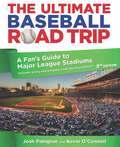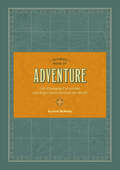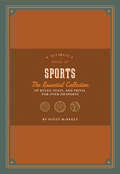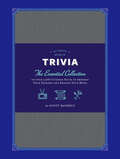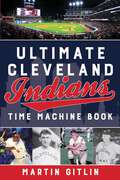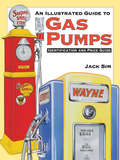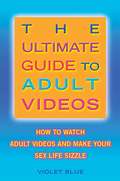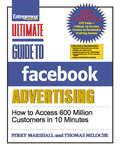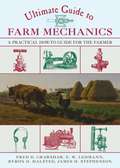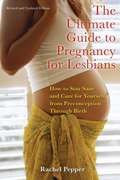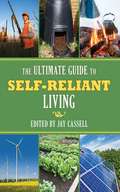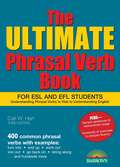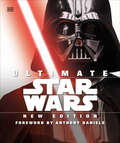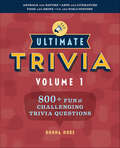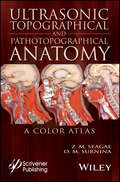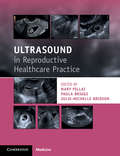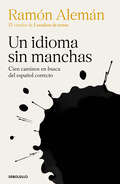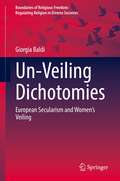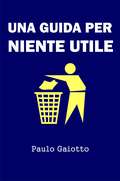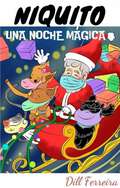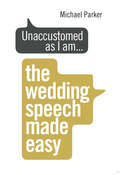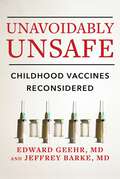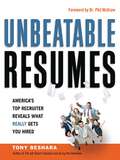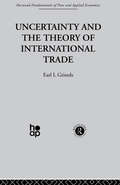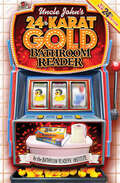- Table View
- List View
Ultimate Baseball Road Trip: A Fan's Guide to Major League Stadiums
by Josh Pahigian Kevin O'ConnellThe most entertaining and comprehensive guide to every baseball fan&’s dream road trip—including every new ballpark since the 2004 edition—revised and completely updated!
Ultimate Book of Adventure: Life-Changing Excursions and Experiences Around the World
by Scott McNeelyBreak out of your comfort zone and find a new adventure in this guide to some of the world’s most amazing experiences.From tracking gorillas in Uganda to cliff diving in Brazil, surfing a volcano in Nicaragua, or starting a tomato fight in Spain, this action-packed guide is bursting with inspiring ideas for trying the unfamiliar, taking risks, or pursuing a new experience. Containing in-depth descriptions and logistical information for each activity, this handbook also features survival skill tips and an adventure kickstart guide. Ranging from death-defying stunts to easy and safe family vacations, Ultimate Book of Adventure has an escapade for everyone and welcomes travel junkies and armchair travelers along for the ride.
Ultimate Book of Sports: The Essential Collection of Rules, Stats, and Trivia for Over 250 Sports
by Scott McNeelyLearn the ins and outs of your favorite game or uncover a new passion with this compendium of knowledge for over 250 sports.This ultimate book for the ultimate sports fan extends far beyond classics like tennis and basketball. With the rules of engagement for an outrageous assortment of sports—from jousting and Mongolian wrestling to baseball, cricket, ultimate Frisbee, and caber tossing—this book is a resource and a revelation for sporting types of all stripes. Including extensive sidebars with tips, trivia, and strategy, as well as classic line art and illustrations throughout, this compendium of competitive games is ideal for brushing up on rules and regulations, settling disputes, or finding a new passion.
Ultimate Book of Trivia: The Essential Collection of over 1,000 Curious Facts to Impress Your Friends and Expand Your Mind
by Scott McNeelyHave fun quizzing your friends—or yourself—with this puzzling collection of over one thousand trivia facts.Did you know that cats can be left-handed? Trivia fans will be eager to dive into this book for an edifying and entertaining tour of all the things they didn’t know that they didn’t know. There is something here for everyone and every occasion, with topics including Space and Science, Being Human, Sports, Music, Food and Drink, and Famous Inventions. It’s full of conversation starters, from Herbert Hoover’s pet alligators to the longest recorded bout of hiccups (it lasted for 68 years). Brimming with surprising facts, this comprehensive collection of trivia is sure to puzzle and delight.
Ultimate Cleveland Indians Time Machine Book
by Martin GitlinAs the anchor titles in a new &“Time Machine&” Lyons Press baseball series, The Ultimate Cleveland Indians Time Machine presents a timeline format that not only includes the Indians&’ greatest moments—including World Series appearances and individual achievements—but would focus also on some very unusual seasons and events, such as the team&’s 20-134 season of 1899 (the absolute worst in baseball history), the "Crybabies" of 1940 (who received this nickname after complaining about their manager to such as extent that fans even turned on them), or the infamous &“Ten Cent Beer Night of 1974&” (when thousands of drunken fans stormed the field and forced the team to forfeit). Of course there are other events to recall, like 17-year-old Bob Feller making his debut and striking out 17 batters in 1936, or Albert Belle famously pointing at his muscle after a playoff opponent claimed (rightly) that he had corked his bat and one of his teammates sneaked into the umpire's room to steal it back so the umps could not find out that it was corked. There are dozens of impressive, wild, wacky and wonderful stories over the years regarding Indians history and Gitlin is the perfect person to write it with his trademark humor and thorough knowledge of Indians lore.
Ultimate Gas Pump ID and Pocket Guide Identification: Identification and Price Guide
by Jack SimFrom the owner of the largest gas pump literature collection in the United States comes the most comprehensive identification and price guide available on collectible gas pumps. Petroliana collectors will find models from every known gas pump manufacturer from 1885 to 1965 in this full-color volume. Listings detail manufacturer, pump model number, years in production, original cost, brief description and history, and current market value. This illustrated reference guide features more than 1,400 images from original petroleum literature. Some of the companies listed include Acme Pump & Tank Company, Chicago Steel Tank Company, Erie Pump Company, United States Pump & Tank Company, and Wayne Tank & Pump Company.
Ultimate Guide to Adult Videos: How to Watch Adult Videos and Make Your Sex Life Sizzle
by Violet BlueJoin the increasing number of women, men, and couples who enjoy adult videos. Whether you're newly curious about the world of adult films or a seasoned porn enthusiast, reviewer and best-selling author Violet Blue tells you everything you need to know to spice up your sex life: * Keys to finding porn that turns you on * Helpful hints for first-time viewing * How to introduce your partner to porn * Answers to common concerns about content * Sex games and positions * How to find authentic sexual performances * The scoop on today's hottest female and male directors * Tons of history, stories, and facts about the porn industry * Tips on buying and renting videos and DVDs * Complete, up-to-date resource guide Plus over 300 detailed video reviews—including porn classics, cult favorites, feature films, and educational videos, as well as films showing all sex with no plot, S/M play, lesbian and gay action, amateurs, and much more.
Ultimate Guide to Facebook Advertising
by Perry Marshall Thomas MelocheCovers critical updates including:-Targeting by birthday, family status, and more-Pinpointing who is seeing your ads-Managing impressions per ad to avoid ad fatigue-Using Sponsored Story Ads-the newest advertising categoy-Creating a Facebook businessp and identityMAKE A FORTUNE WITH FACEBOOKPerry Marshall, author of the #1 selling book on Google advertising, and internet strategist Thomas Meloche lift the curtain to the 600 million potential customers on Facebook and show you how to reach them, convert them, and keep them as your fan, friend, and customer for life. Introducing game-changing strategies, tools, and reports, Marshall and Meloche breakdown the magic of Facebook Paid Advertising and show you how to gain dramatically on your investment-in clicks, customers, and profits.Perry and Tom not only understand every nuance of the technical aspects of getting Facebook ads to work for your business, they also understand the psychology behind what works and what doesn't when it comes to advertising online. If you're looking for an uber-effective way to master the art of driving traffic to your offers through paid advertising, get this book - it truly is the ultimate guide!-Mari Smith, co-author of Facebook Marketing: An Hour A Day and author of The New Relationship MarketingIf anybody can make practical sense of Facebook for marketers, it's Perry. He has his finger on its truth - as advertising media not social media. This book shows how to capitalize on ideal timing with this media. He is a well-disciplined direct-response practitioner who holds this accountable for ROI. I bestow my 'No B.S. blessing.'-Dan S. Kennedy, legendary direct marketing advisor and author of the No B.S. book series, www.NoBSBooks.comUltimate Guide to Facebook Advertising just might be your ultimate guide to earning a ton of money with this social media phenomenon. What you don't know about Facebook could hurt you and what you will learn about Facebook from this book definitely will help you. It's a fun and easy read and a surefire way to seriously increase your income.-Jay Conrad Levinson, The Father of Guerrilla Marketing, author of Guerrilla Marketing series of books
Ultimate Guide to Farm Mechanics: A Practical How-To Guide for the Farmer (Ultimate Guides)
by Fred D. Crawshaw Byron D. Halsted Emil W. Lehmann James H. StephensonA reference and instruction guide to the mechanics of working the land.The Ultimate Guide to Farm Mechanics combines three classic farming texts for the first time, compiling knowledge from the best sources published as far back as 1884. A comprehensive reference book that belongs in any farming household today, it offers an array of farm knowledge for both experts and amateurs alike.The book is divided into three parts: the first covers general skills such as woodworking and blacksmithing, the second is dedicated to farm engines and how to run them, and the third teaches readers how to construct classic labor-saving devices such as an effective milking stool, plowing gear for a kicking mule, and a nest for egg-eating hens. Readers are taught to mend broken tools, make fertilizer and corn fodder, buy engine parts, and manage gasoline engines safely and economically.Filled with intricate illustrations, photos, and diagrams, Ultimate Guide to Farm Mechanics offers a wealth of knowledge still indispensable to the modern-day farmer. Both the casual and amateur reader will learn valuable lessons from the old teachers of early twentieth-century farming in the United States.
Ultimate Guide to Pregnancy for Lesbians: How to Stay Sane and Care for Yourself from Pre-conception Through Birth
by Rachel PepperThe Ultimate Guide to Pregnancy for Lesbians covers everything you need to make the thrilling and challenging journey to motherhood: from choosing a donor to tracking fertility to signing the right papers on the dotted lines. Rachel Pepper's lively, easy-to-read guide is the first place to go for up-to-date information and sage advice on everything from sex in the sixth month to negotiating family roles.Why a second edition? When the acclaimed first edition appeared, the author's daughter was only a few months old. This new edition takes into account the parenting know-how Pepper has developed over the intervening six years, as well as the evolving legal status of lesbian parents, and the increasing importance of the Internet for information on fertility, sperm banks, and donors. The resource section is greatly expanded, as are the sections on each trimester of pregnancy, on childbirth, and on life with a newborn. And Pepper provides more insight into preconception planning for both single lesbians and couples. An indispensable resource, The Ultimate Guide to Pregnancy for Lesbians is now bigger and better.
Ultimate Guide to Self-Reliant Living, The
by Jay CassellBeing a homesteader today may seem difficult; the world is full of so many gadgets and conveniences, many of which most of us consider necessary to live a full and happy life. In this collection, edited and arranged by Jay Cassell, you'll see that going off the grid, adapting to your surroundings, and depending on yourself and your land is really not as challenging as one may think. With the information and tips you learn in this book, you'll easily find success as a modern-day homesteader.The essays featured in The Ultimate Guide to Self-Reliant Living were written by some of today's most respected outdoorsmen and outdoorswomen, nature enthusiasts, agricultural professionals, and successful homesteaders. Through the information on these pages, you will learn the best techniques and approaches concerning:Hunting, fishing, and trappingForagingGrowing and preparing your own foodAnimal husbandryLiving off the gridBuilding barns and outbuildingsGreen livingCountry skillsAlternative energy, such as solar panels and windmillsPrimitive survival skills, such as making fires and finding shelter
Ultimate Phrasal Verb Book, 3rd edition: For Esl And Efl Students
by Carl W. HartUpdated to reflect questions found on the most recent ESL tests, this book presents 400 common phrasal verbs as they are used in everyday English. Phrasal verbs are verbs combined with prepositions or adverbs. Familiarity with phrasal verbs and understanding their use as nouns (breakup, showoff, etc.) or adjectives (spaced-out, broken-down, stressed-out, and many others) is essential to ESL students. Updated information includes: the most commonly used phrasal verbs; activities and examples that reflect our current technology and the world around us; an expanded introduction for the teacher with a thorough breakdown and explanation of phrasal verbs; and, a discussion of separable and inseparable phrasal verbs in Unit I, and more. This book’s hundreds of examples in context and hundreds of exercises will be extremely useful to ESL students who are preparing for TOEFL or who simply wish to improve their English.
Ultimate Star Wars, New Edition: The Definitive Guide to the Star Wars Universe
by Daniel Wallace Ryder Windham Adam Bray Cole Horton Tricia BarrEvery significant Star Wars character, creature, location, battle, droid and vehicle: one ultimate encyclopedia.Packed full of information, stunning images, and now fully updated to include The Last Jedi, Solo: A Star Wars Story, Star Wars: Resistance, plus an exclusive look at The Rise of Skywalker.All the saga's iconic characters are here, from Darth Vader to Ponda Baba and Leia to Luminara Unduli. Amazing vehicles are explored, such as the Millennium Falcon and Ghost. Extraordinary technology is explained, including all your favourite lightsabers, and key events in the epic Star Wars story are richly unpacked, with behind-the-scenes insights.Ultimate Star Wars New Edition is the ideal go-to resource for fans who wish to brush up on their Star Wars knowledge, and for a new generation of fans eager to start their journey into a galaxy far, far away....© & TM 2019 LUCASFILM LTD.
Ultimate Trivia, Volume 1: 800+ Fun and Challenging Trivia Questions
by Donna HokeBecome a triumphant trivia bossIf you want to impress people with your wide-ranging knowledge at the next game night, pick up Ultimate Trivia, Vol. 1. The 800-plus questions in this book are spread over amusing and diverse categories creating a wide and fun playing field for everyone.Pass the time on a cross-country road trip with questions on literature and fine arts. Test your family's historical knowledge at the next holiday gathering. Or belly up to the bar and engage in a Q&A about animals and nature. It doesn't matter the setting—this trivia book is perfect.Ultimate Trivia, Vol. 1 includes:A variety of formats—Try team vs. team in group play or go head-to-head with a friend to see who comes out as a trivia master.Checked and double-checked—All the information has been strenuously fact-checked to ensure everything is accurate and up to date.So many subjects—You name it, it's probably covered: US and world history, pop culture and food and drink—it has it all.Leave a lasting impact at the next trivia night with this brain-busting book.
Ultrasonic Topographical and Pathotopographical Anatomy: A Color Atlas
by O. V. Surnina Z. M. SeagalWritten by experienced and well-respected physicians and professors, this new all-color volume presents the ultrasonic topographical and pathotopographical anatomy of the body, including the head, neck, chest, anterolateral abdominal wall, abdominal organs, retroperitoneal space, male and female pelvises, and lower extremities. Specific and non-specific ultrasonic symptoms are suggested for normal and abnormal developmental variants, diffuse and local pathotopographical anatomy. This color atlas contains comparative topographical and pathotopographical data and is the first manual of its kind for students and medical specialists in different areas, including those specializing in medical sonography. The original technology was tested at clinics in patients subjected to ultrasonic monitoring. Because of early detection there were no false-positive or false-negative results. The therapy was effective, and, in some cases, the use of the original method of "seagalography" (optometry and pulsemotorgraphy) has made it possible to develop new methods of treatment and/or to determine the optimal doses of drugs, as well as to develop effective drug complexes for treatment of a given pathology. This important new volume will be valuable to physicians, junior physicians, medical residents, lecturers in medicine, and medical students alike, either as a textbook or as a reference. It is a must-have for any physician's library.
Ultrasound in Reproductive Healthcare Practice
by Paula Briggs Mary Pillai Julie-Michelle BridsonChallenge your knowledge of ultrasound to address sexual health abnormalities and early pregnancy issues, alongside identifying, classifying and managing a wide range of gynaecological conditions, with this essential manual. Authored by experts in reproductive health, this bespoke guide delivers practitioners of all levels with a broad scope of sexual and reproductive disorders, as captured by ultrasound. Presenting operational issues and suggested training, this textbook ensures high-quality care in gynaecology, sexual and reproductive health and pregnancy advisory services. For use in a traditional hospital setting through to more remote locations, this guide provides an invaluable toolkit for trainees, sonographers, nurses and clinicians worldwide. Offering clear clinical ultrasound images and extensive case studies with a focus on pregnancy advisory services, this adaptable textbook provides reliable support for those who are in contact with common, rare and understudied reproductive conditions, wishing to achieve successful diagnosis and optimal imaging first time. Bespoke and wide-ranging, this guide encompasses a range of understudied medical gynaecological conditions and early pregnancy issues, through to contraception and sexually transmitted infections. The first of its kind in using ultrasound as a tool to address conditions specific to sexual reproductive healthcare. Formalises ultrasound practice within sexual reproductive healthcare for the hospital setting, and remote settings, away from mainstream radiology services. Includes clear illustrations of clinical and ultrasound images, and case studies tailored to challenging pregnancy advisory services.
Un idioma sin manchas: Cien caminos en busca del español correcto
by Ramón Alemán100 curiosidades sobre la lengua española que contagian entusiasmo y amor por un idioma que puede ser hermosamente complejo Ramón Alemán, corrector de textos y periodista con décadas de experiencia, nos trae en este libro una guía práctica para mejorar el uso de nuestro idioma a través de anécdotas y ejemplos explicados con rigor, humor y sencillez. En estas páginas, responde a las dudas que nos surgen en el día a día como hispanohablantes y nos trae la sabiduría de los grandes conocedores y expertos del español. Así, los misterios de la gramática y la ortografía se desvelan sin esfuerzo, y antes de que nos demos cuenta han quedado resueltos.
Un-Veiling Dichotomies: European Secularism and Women’s Veiling (Boundaries of Religious Freedom: Regulating Religion in Diverse Societies)
by Giorgia BaldiThis book analyzes the implication of secular/liberal values in Western and human rights law and its impact on Muslim women. It offers an innovative reading of the tension between the religious and secular spheres. The author does not view the two as binary opposites. Rather, she believes they are twin categories that define specific forms of lives as well as a specific notion of womanhood. This divergence from the usual dichotomy opens the doors for a reinterpretation of secularism in contemporary Europe. This method also helps readers to view the study of religion vs. secularism in a new light. It allows for a better understanding of the challenges that contemporary Europe now faces regarding the accommodation of different religious identities. For instance, one entire section of the book concerns the practice of veiling and explores the contentious headscarf debate. It features case studies from Germany, France, and the UK. In addition, the analysis combines a wide range of disciplines and employs an integrated, comparative, and inter-disciplinary approach. The author successfully brings together arguments from different fields with a comparative legal and political analysis of Western and Islamic law and politics. This innovative study appeals to students and researchers while offering an important contribution to the debate over the role of religion in contemporary secular Europe and its impact on women’s rights and gender equality.
Una guida per niente utile
by Paulo GaiottoUna raccolta di guide per niente utili alla tua vita (magari non fosse così). Come diventare un pastore? Come suicidarsi? Come dimenticare un grande amore? E altri ‘come fare’ Semplicemente una satira divertente su "manuali pratici" e di "auto-aiuto".
Una noche mágica
by Dill FerreiraLos Ángeles con Patas son un grupo de mascotas que ayudan a otros animales en dificultades como cuando tienen un accidente, están enfermos, en riesgo, o están descontentos en sus casas y necesitan ayuda. En esta historia se enteraron por uno de sus integrantes que debido al Covid-19 pocas personas habían colaborado para las fiestas navideñas y que Santa no tendría suficientes regalos para los niños. Así, intentarán ayudar a Papá Noel a hacer una Feliz Navidad a los niños. Y demostrarán que la amistad, el amor y el entusiasmo marcan la diferencia en nuestras vidas.
Unaccustomed as I am...: The Wedding Speech Made Easy
by Michael ParkerAll wedding types will be catered for: big, small, religious, second marriage, atheist, straight, same-sex, church, field... All speakers will be addressed: bride, groom, father, mother, best woman and literally everyone in between... All eventualities will be planned for: mic failures, drunk guests, missing brides, smashed glasses, weeping FOBs, forgotten words... All of which will be delightfully and wittily illustrated, with a mix of little-known wedding facts and a whole host of inspirational (or not) quotations.
Unavoidably Unsafe: Childhood Vaccines Reconsidered
by Edward Geehr Jeffrey BarkeAn in-depth guide for parents as they struggle to make informed decisions about vaccines for their children. In Unavoidably Unsafe, Dr. Edward Geehr and Dr. Jeffrey Barke confront the prevailing beliefs surrounding childhood vaccines with unflinching scrutiny and bold insight. As seasoned physicians, they acknowledge the revered status vaccines hold in modern medicine while bravely questioning their safety and efficacy. From the historical triumphs of polio eradication to the complexities of modern immunization schedules, Geehr and Barke unravel the layers of vaccine development and regulation. They shed light on the unintended consequences of vaccine mandates and the erosion of informed consent in the face of mounting pharmaceutical influence. Drawing on decades of clinical experience and exhaustive research, the authors challenge conventional wisdom by addressing critical issues such as: The proliferation of childhood vaccines and their impact on public health The National Childhood Vaccine Injury Act and its implications for vaccine safety The symbiotic relationship between pharmaceutical companies and regulatory agencies The shortcomings of Emergency Use Authorization and its implications for vaccine safety The presence of potentially harmful additives in vaccine formulations A fresh look at possible links between vaccines and autism Cautionary considerations regarding mRNA vaccines and their suitability for children Practical guidance for evaluating the risks and benefits of vaccines for individual children The significance of proper informed consent and patient advocacy in vaccination decisions Unavoidably Unsafe is not an indictment of vaccines but a call to arms for informed decision-making and transparency in healthcare. Geehr and Barke aim to empower parents, guardians, and healthcare providers with the knowledge needed to navigate the complex landscape of childhood immunization responsibly. In a rapidly evolving medical landscape where uncertainties abound, Unavoidably Unsafe serves as a beacon of clarity and integrity, reaffirming the importance of critical thinking and patient-centered care in safeguarding the health and well-being of future generations.
Unbeatable Resumes: America's Top Recruiter Reveals What REALLY Gets You Hired
by Tony BesharaThis helpful resource shows job seekers of all types how to present themselves in the best possible light--and land the best possible position.Unlike most resume &“experts,&” Tony Beshara doesn&’t merely write resumes. As a veteran placement specialist who&’s been featured regularly on the Dr. Phil show, Tony uses resumes to get people jobs. Now, in this dynamic book, he&’s drawing on expertise gained from placing more than 8,500 professions to help you create a powerful resume that stands out from other applications. Unbeatable Resumes takes you step-by-step through the resume creation process, including tips on how to utilize keywords effectively, use gaps in employment and job changes to your advantage, and enhance your resume with a concise, dynamic cover letter. You&’ll also discover how to:ensure your resume gets read by the right people;what employers look for on applications and what turns them off;how to customize a resume for a particular job;and the true value and detriment of digital tools including video resumes, job-search websites, and social networking sites like Facebook and LinkedIn.With detailed examples and discussions on the assets and pitfalls of real-life resumes submitted for jobs in a wide range of industries, Unbeatable Resumes will take your job hunt skills to the next level.
Uncertainty and the Theory of International Trade
by E. GrinolsThis book considers the impact of uncertainty on traditional theories of international trade.
Uncle John's 24-Karat Gold Bathroom Reader (Uncle John's Bathroom Reader Annual #24)
by Bathroom Readers' InstituteThe twenty-fourth edition in the bestselling bathroom-reading series is jam-packed with over 500 pages of absorbing trivia material. The information miners at the Bathroom Readers&’ Institute have unearthed a priceless collection of surprising, amazing, head-scratching, and hilarious articles. Divided by length for your sitting convenience, 24-Karat Gold is chock-full of little-known history, random origins, weird news, celebrity secrets, and urban legends. As always, you&’ll find plenty of dumb criminals, clever wordplay, quirky quotations, and much, much more. Just open to any page—who knows what treasures await you? · Judges gone wild · The Barbie scandals · Canada&’s underpants king · Helen Keller: vaudeville star · The double A-bomb survivors · The history of the umbrella · America's forbidden island · What the Hokey Pokey is really all about And much, much more
